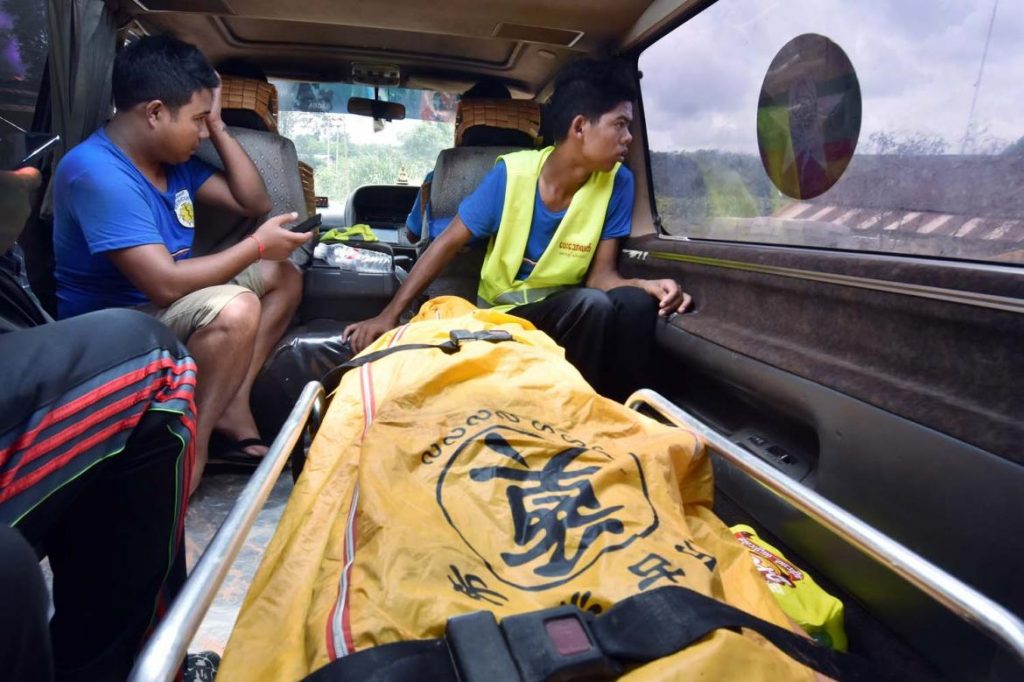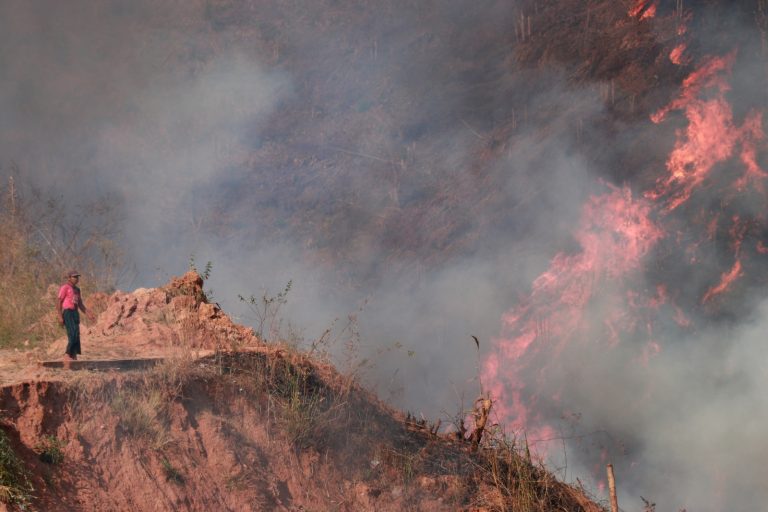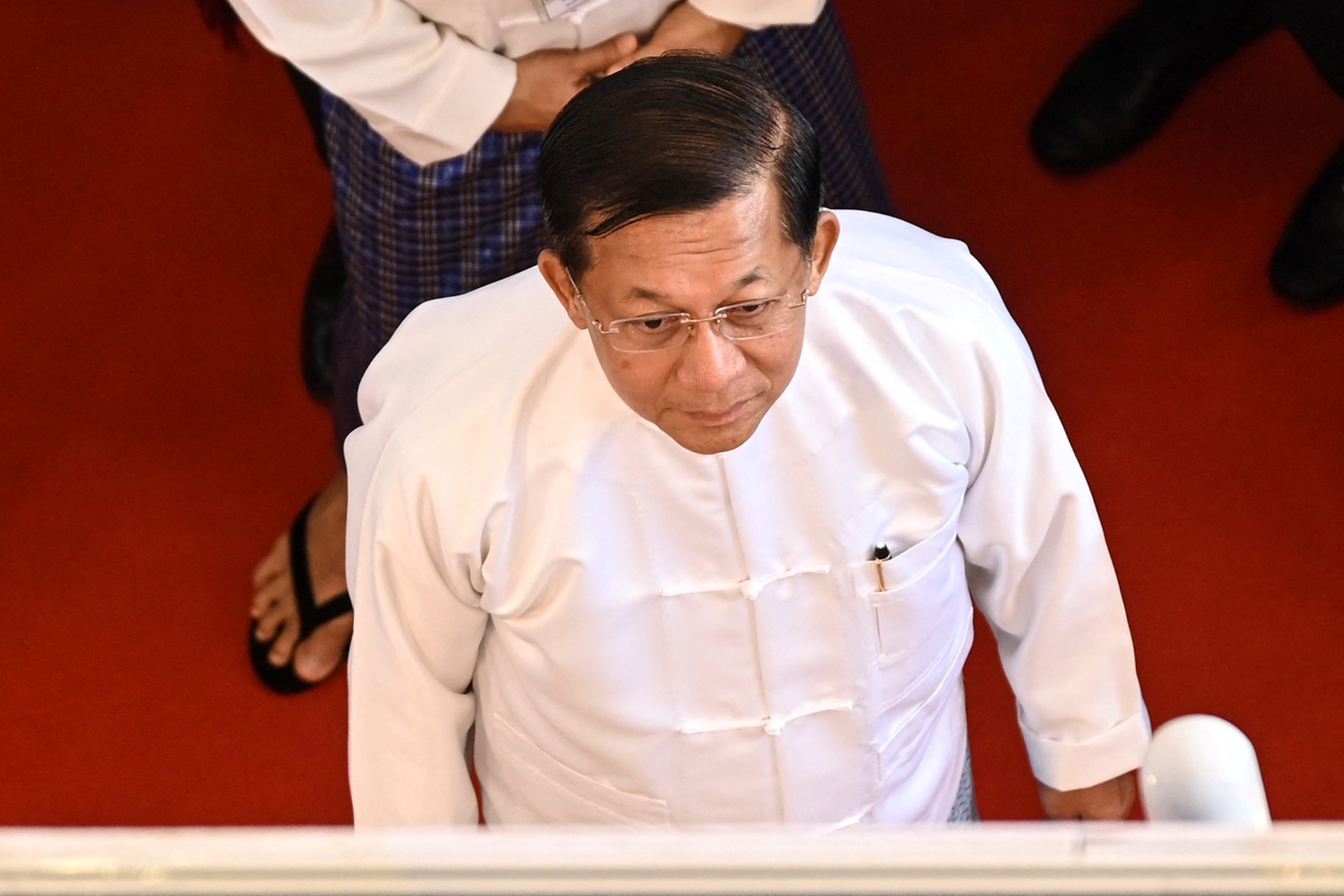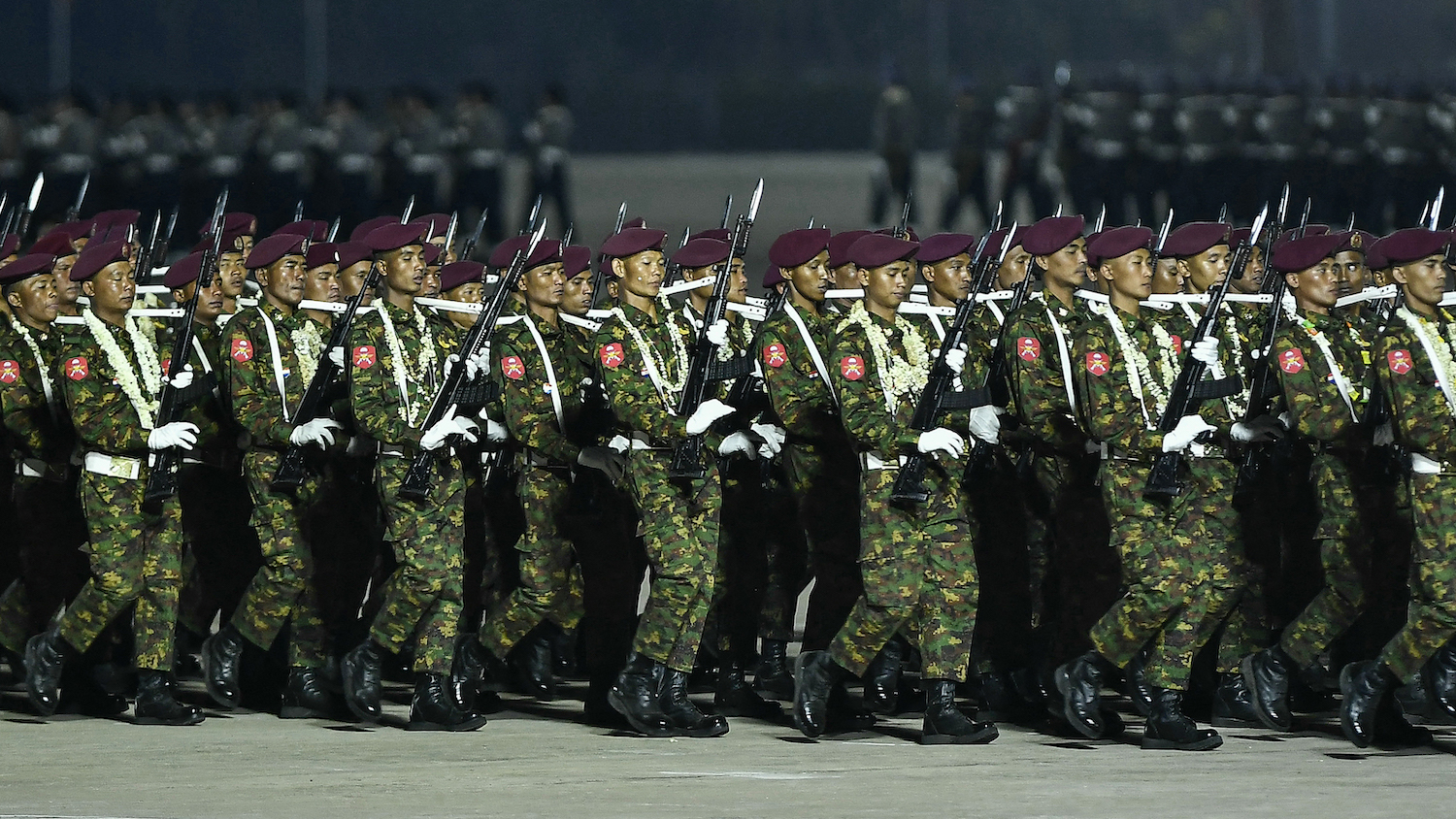Volunteers with community service ambulances in northern Shan State are taking big risks to help others in conflict zones – and sometimes pay with their lives.
By KYAW LIN HTOON | FRONTIER
THE SMELL of the bodies permeates through the minivan as we make the 32-kilometre journey back to Lashio.
In the back of the ambulance – a Toyota Super Custom minivan – are two yellow bags containing the bodies of U Win Maung, 61, and his wife, Daw Aye Mya, from Man Kaung village.
The smell doesn’t seem to bother the volunteers from the Giving Hand aid group. As we pull out of Man Kaung, Ko Kaung Zaw, 22, slips down the surgical mask on his face and takes a long drink of Sprite from a bottle that had been resting beside the body bags.
For most of the journey back to Lashio, Kaung Zaw, who has been volunteering with Giving Hand for about three years, scrolls through Facebook on his phone, paying little attention as the bodies slide around due to the winding road.
Support more independent journalism like this. Sign up to be a Frontier member.
But this was no ordinary emergency. Win Maung, a former member of the Tatmadaw, was the leader of the Mong Yan militia. The couple were killed when their home was bombarded with grenades and M79 grenade-launcher fire in an apparently targeted attack on the evening of August 20.
The attack came three days after three members of the Northern Alliance of ethnic armed groups – the Ta’ang National Liberation Army, the Myanmar Democratic Alliance Army and the Arakan Army – issued a statement warning that any members of government security forces found in operational areas would be “duly taken care of for the sake of self-defence”.
Because the Tatmadaw and the authorities had warned ordinary citizens not to handle the dead in such situations, Man Kaung residents avoided Win Maung’s home after the attack. But the security forces had also made no attempt to recover the bodies; instead, the remains had sat in the ruined home for more than 12 hours before the Giving Hand volunteers arrived.
Aid groups in Lashio had wanted to travel to Man Kaung village as soon as they heard of the attack, but did not receive permission from the Tatmadaw and the General Administration Department until the next day.
Sai Han, chair of the Tai Youth Organisation – a civil society group based in the state capital Taunggyi, with branches in northern Shan – travelled ahead of Giving Hand’s ambulance to Man Kaung to negotiate with officers at Tatmadaw checkpoints along the way.
When we arrived in the village, the three volunteers had walked quickly through the burned out home, apparently unconcerned about the potential threat of unexploded ordnance. The volunteers even took pictures of the scene, which they later provided to the authorities.
“We’re not scared by this – especially not on seeing badly disfigured bodies,” explained Kaung Zaw. “After a while you just get used to it.”
dsc_9791.jpg

The bodies of militia leader U Win Maung and his wife Daw Aye Mya are carried into an ambulance for transportation to Lashio General Hospital. (Steve Tickner | Frontier)
Collecting the bodies of the dead is one of the most unpleasant, and sensitive, tasks that community service ambulances are undertaking in northern Shan State.
Operated by altruistic volunteers, the ambulances – mostly marked civilian cars equipped with limited life-saving equipment – fill a vital need that the government and the Myanmar Red Cross are often unable to provide because of a lack of resources.
When there is no active conflict, the ambulances attend car accidents, transport the sick or injured, and provide free funerals. But since hostilities flared in northern Shan State on August 15, the ambulance service groups have focused mostly on providing care and comfort to people displaced by the fighting and retrieving the dead bodies of civilians and military personnel.
The fighting between the Tatmadaw and the three ethnic armed groups has sometimes been intense. Figures released by the United Nations showed that by September 4 the conflict had killed at least 27 civilians, injured 27, and displaced about 7,500. By September 7, all but 1,600 had been able to leave monasteries and other temporary shelters and return to their homes.
In providing this service during times of conflict, the volunteers are risking their own lives. Ambulances have been targeted at least twice since August 15, according to community service leaders in Lashio and nearby Kutkai Township.
They suspect that one of the members of the Northern Alliance was responsible for the fatal August 17 attack on a rescue vehicle.
An explosive device that detonated near the van inflicted a fatal shrapnel wound on the driver, U Tun Myint, chairman of the Lashio Youth Social Support Association, causing the vehicle to run off the road and overturn.
Two of the three passengers in the van were injured in the incident, which occurred about 20 kilometres from Lashio while the van was on a mission to rescue people injured in the fighting.
The attack on a clearly marked rescue vehicle was condemned by peace activists and conflict monitors, some of whom said it amounted to a breach of the Geneva Conventions. It came the same day that an ambulance operated by the Myittar Shin group, based at Nam Hpat Kar town in Kutkai Township, suffered minor damage when it was hit by bullets during fighting along the Lashio-Muse road about 69km from Lashio, in an incident in which no one was hurt.
Article 19 of the 1949 Geneva Convention states that hospitals and mobile medical units “may in no circumstances be attacked, but shall at all times be respected and protected” by parties to a conflict.
A spokesperson for the Ta’ang National Liberation Army said he did not know if the van was targeted by it or the Tatmadaw.
dsc_8960.jpg

Mourners at the funeral of U Tun Myint, held at Lashio’s Muslim cemetery on August 17. (Steve Tickner | Frontier)
U Myo, a member of the Karuna ambulance aid group formed in August last year in Kutkai town, told Frontier that members of the Northern Alliance were “intentionally spreading misinformation” that rescue vehicles were being used to transport Tatmadaw troops.
“I think the ambulances are being attacked because of that misinformation,” he said, but did not provide evidence to support the accusation.
Sai Han condemned those responsible for spreading the misinformation that ambulances were transporting Tatmadaw personnel.
“Ambulance drivers are not stupid,” he told Frontier. “They would never do anything that violated their ethical responsibilities.”
“We do not need to use the vehicles of social welfare organisations; the Tatmadaw has its own vehicles,” Tatmadaw spokesperson Brigadier-General Zaw Min Tun was quoted as saying in the Myanmar Times on August 30, in what the newspaper said was a response to an accusation from the TNLA that the Tatmadaw was using humanitarian groups’ vehicles to transport troops.
The Myanmar Times did not quote this accusation, and Frontier could not corroborate that it was made.
The Tai Youth Organisation does not have any ambulances, but Sai Han often drives his sedan at the head of convoys of rescue vehicles on missions to collect the injured or transport villagers displaced by fighting to safe areas.
A former officer in the Shan State Army-North, armed wing of the Shan State Progress Party, Sai Han smooths the way when rescue convoys are stopped at Tatmadaw checkpoints.
This is necessary despite the convoys having already received permission for their missions from higher levels of the Tatmadaw and from the GAD.
Sai Han said a reason for the attacks on ambulances was that lower-ranking members of the Tatmadaw and ethnic armed groups are usually ignorant of the Geneva Conventions, as well as being illiterate.
“So it would not be strange if such personnel wrongly opened fire on an ambulance fitted with sirens and blue and red flashing lights similar to those on police vehicles,” Sai Han said.
dsc_9287.jpg

Tai Youth Organisation chair Sai Han (left) discusses arrangements for IDPs with group member Nang Htwe Lu (right) in Kone Sar village. (Steve Tickner | Frontier)
There are about 20 volunteer-based community ambulance groups in Lashio and four in Kutkai, and most were established in the last 10 years. They are all members of the Myanmar Rescue Federation, which is recognised by the government. Most of the ambulance groups, in common with those elsewhere in Myanmar, are township-based and funded by people in the community.
Most of the volunteers in northern Shan are the owners of small or medium-sized businesses such as grocery stores, teashops and gold shops.
Small ambulance groups run by local volunteers have existed in Myanmar since the 1990s, when the dismantling of the socialist economy led to a surge in private welfare provision, but they have proliferated and spread across the country over the past decade with increased conflict in areas such as Shan State, the relaxing of restrictions on civil society organisations and a sharp decline in car prices.
Sai Han said that the first of the community ambulance groups in Lashio were founded by Bamar and had Bamar drivers. He said this could be because they were more prepared than other ethnic nationalities to help all members of the community.
“They are brave and take risks and are ready to help when it is needed by a Shan or a Palaung [Ta’ang],” Han said, adding that this was why the authorities and ethnic armed groups should do what they can to ensure that the ambulances never come under attack.
“If such brave people become afraid of going out and helping the injured, who can we rely on?” he said.
U Tin Win, 48, who is in charge of Kutkai-based humanitarian aid group Brahmaso Heart, said the volunteer organisations were essential because they performed emergency services that the government and the Myanmar Red Cross were often unable to provide.
“Most of the time, if we did not go to areas where people needed help, there would be no one to take the lead,” he said.
He said the biggest problem that multi-ethnic Brahmaso Heart faced when it was established in Kutkai eight years ago was that residents did not understand the concept of a community-based ambulance service operated by volunteers.
“We started this work with funds provided by myself and friends but as the community began to appreciate our work and the help we provide, we began receiving donations from residents of the township,” Tin Win said.
All the ambulance groups said they needed more funding to buy or upgrade their equipment. Many of the ambulances are Toyota minivans that carry oxygen tanks and are manned by volunteers, though not all of them have been trained as paramedics. Stickers on the vehicles identify the group operating them as a member of the Myanmar Rescue Federation.
U Myo from Karuna said his group had been able to attract more donations as appreciation grew among community members of its ability to rescue people affected by fighting. “People have been donating more and more and now we have four ambulances,” he said.
He said Karuna was saving up to buy a four-wheel-drive that would be useful for rescue missions in mountainous areas.
dsc_9830.jpg

The ambulance that was hit by an explosion on August 17 while travelling the Lashio- Muse highway, in an attack that killed the driver, rescue service chairman U Tun Myint. (Steve Tickner | Frontier)
U Myo said the ambulance groups did not receive any support from the government and relied entirely on donations from members of the communities in which they operated. Donors include businesspeople and the families of public servants, as well as ordinary citizens.
Giving Hand founder U Myint Maw, 42, said the volunteers on its three Lashio-based ambulances had been well trained, including in providing first aid and following rules issued by the Myanmar Police Force, such as when someone has been killed in a vehicle accident. In such cases the volunteer services must wait until the police attend at the scene before they can remove the body. In cases where people suffer injuries, the rescue services can provide immediate care and provide transport to hospitals.
As well as transporting IDPs and the injured, the rescue vehicles also deliver food and other necessities to people who are either trapped by fighting or are prevented from leaving their homes. In some cases people refuse to leave conflict areas because they want to look after their homes, property and livestock.
Myint Maw said the work was as rewarding as it was risky.
Despite the apparent lack of fear shown by some of the Giving Hand volunteers, he said, “Whenever we go on rescue missions, we are frightened all the time. But if we did not go, the situation faced by the IDPs and injured would be worse.”







